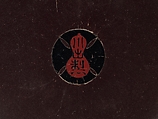Imperial Presentation Vase with Maple Branches and Imperial Chrysanthemum Crest (one of a pair)
Kawade Shibatarō Japanese
Not on view
Outlined in gold wire at the front and back of these vases is the imperial crest (mon): a chrysanthemum with thirty-two petals. Items bearing the imperial crest were often presented as gifts to foreign dignitaries. This vase from a pair, however, was offered by Emperor Meiji in 1906 to the cartoonist Henry Mayer (1868–1954) to thank him for a set of drawings after cartoons he had published in The New York Times on the Russo-Japanese War.
In the repoussé (uchidashi) technique used for the larger floral motifs, portions of an underlying metal substrate are hammered outward to create protuberances. It was used for the first time in Japanese enameling in 1902 by the Andō Company and its factory head, Kawade Shibatarō. In 1900, in recognition of the quality of its wares, Andō was appointed one of five Purveyors to the Imperial Household (Goyōtatsu) for cloisonné enamel. Here, the intricate foliage designs at the rims are intended to remind one of the brocades that frame Japanese scrolls and to reference that traditional art form. They are particularly extensive near the top, and include images of the imperial hō-ō phoenix, a bird symbolizing enlightened government.
Due to rights restrictions, this image cannot be enlarged, viewed at full screen, or downloaded.
This artwork is meant to be viewed from right to left. Scroll left to view more.






